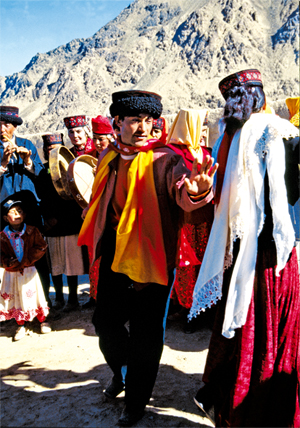Written by: Cheng Wanli
Posted on: July 02, 2013 | 
Grand get together on the Pamirs
The Tajik people are scattered throughout China, Tajikistan, Afghanistan, Uzbekistan, Pakistan, and India. There are the Tajiks of the plains and those of the highlands. The majority of the Tajik people inhabit the Taxkorgan Tajik Autonomous County in Kashgar area and Zepu, Shache, Yecheng, Pishan and Aktao Counties in southern Xinjiang, with a population of over 40,000. These are the highland Tajiks and the only original white people speaking the Indo-European language.
 |
| Tajik Eagle Dance |
The Pamirs plateau where the Tajik people live is a converging place of the Tianshan, Kunlun, Gangdisi, Xindukushi and Himalaya Mountains. A Tajik proverb says, “A person’s navel is on his belly while the world’s navel is on the Pamirs”. The flying eagle is their totem and receives great worship. The Tajiks believe that the eagle is the king of animals and represents an image of honesty, kindness, bravery, strength, and justice. Therefore, heroes, sages, and outstanding young men are respected by the Tajiks as eagles. The eagle flute and eagle dance evidently show their worship to this bird.
There are more than a dozen legends concerning eagles, and four concerning the eagle lute and eagle dance. Although the details of these legends vary slightly, they all tell a similar story: a kind Tajik was bullied by evil. An eagle helped the poor Tajik to resist and died ultimately in order to protect the man. The eagle asked the kind person to make a lute with his wing bone. When the lute is played, the world will be full of happiness. Then the kind person played the lute and girls began to imitate the eagle’s actions with the music. Gradually, the Tajik arts - the eagle flute and eagle dance - came into being.
Because these dance movements imitate the movement of eagles, the traditional Tajik dance is named the Eagle Dance, derived from their worship of their gods and ancestors (including the totem). The steps of the dance imitate the eagle’s soaring, diving, wheeling and joyful flying. A seven-eighth rhythm is used for both the music and the dance. At first, one dancer goes onto the field and dances. Then he invites another. They begin to move forward slowly with their arms spread, like two eagles hovering. When the music begins to play faster, they chase and play with each other. Once they get close, they spin away immediately. They rise or squat suddenly, or jump while spinning. The women’s dance movements are much softer, but also imitate eagles. There are no fixed dance steps, so everyone can dance in their own style. At festivals, wedding ceremonies, and other gatherings, two musicians alternatively play eagle flutes and two women beat the hand-drum (a small drum similar to the tambourine), while the old and young alike join in the spectacular dance.
You may also like: